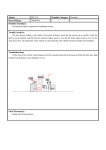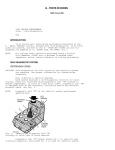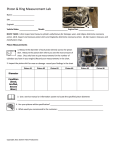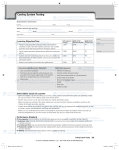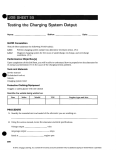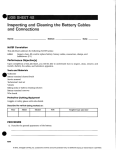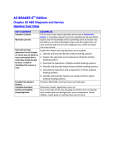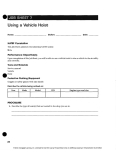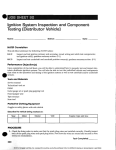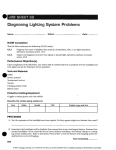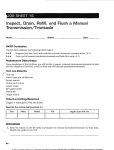Download Lab # 6 Work Orders, Vehicle Identification, Fuses, and Volt Drop
Transcript
Name (s) __________________________ _____________________ Please limit lab groups to 2 students per vehicle . Lab # 6 Work Orders, Vehicle Identification, Fuses, and Volt Drop 2013 NATEF tasks 277, 278, 280, 281, 287. Select any vehicle newer than 1983. Find and record VIN number: VIN______________________________ To decode the VIN, look up this vehicle in ALL Data or ShopKeyPro. In ALL Data look for “Application and ID” on the right side of screen. For directions on how to look up a vehicle in ShopKey Pro, go to http://elearning.linnbenton.edu/mod/page/view.php?id=148917 (requires moodle login) In ShopKey search for “VIN code ID” or vehicle “identification number” Then look through the Tabs (it is often found in the “Add’l…” tab) Record the VIN digit that specifies the model year _______________ Record the VIN Digit that specifies the engine size ________________ What else will the VIN number tell you about this vehicle? All modern vehicles require an emissions decal to be located in the engine compartment. List out what the Emission Decal tells you about this vehicle (on older vehicles this decal may be missing – find one from any car for this question) Why is it important to ensure the correct engine and year, according to the VIN, or Emissions Decal, is recorded on the work order? To complete a Work Order you will need this information: Model Year ____ Make ______________ Model ___________ Engine Size ________ Build Date_________ Odometer Reading__________ License Plate ___________ Instructor Check ______________ Page 1 of 5 FUSES and FUSIBLE LINKS NEVER install a fuse unless you are certain of the proper amp rating. Do not assume the fuse you remove is the proper rating! The fuse panel cover may have amp ratings for each fuse however you often have to look this up to be sure you use the proper fuse! Fuse information can be easily located in ShopKey by searching for “power distribution” In ShopKey, figure out what each of these Tabs tell you about the “power distribution”. Descriptions - Locations - Procedures - Diagrams - Add'l Articles 1 - There are often Cautions or Warnings for working on the Power Distribution system. Find and be prepared to discuss these service precautions. NOTE: If your vehicle has none, search power distribution for a 1992 Jeep Cherokee 4.0L Laredo 2 - Demonstrate how to find the proper amp rating for fuses, fuse locations, what circuits a fuse will protect, and discuss the power distribution wiring diagram. 3 - Locate a fuse panel, turn the key to the run position and check the voltage reading at each end of the fuses. 4 - Use a 12 volt test lamp to test these same fuses. 5 - Older vehicles use wire fusible links. Discuss with your instructor how a fusible link works, what is special about the insulation, and how to properly solder new fusible links. 6 - Locate a fusible link in your vehicle. (Newer vehicles may not use wire fusible links. If your vehicle does not have one find fusible links for a 2000 Dodge Caravan) Demonstrate Fuse Link location and replacement wire gauge for the Fusible link. Instructor Check ______________ Page 2 of 5 Technical Service Bulletins Technical Service Bulletins (TSB’s) are written by car manufacturers when they find a problem that often occurs in the type of vehicle you are working on. TSB’s can really help technicians quickly find the correction for commonly occurring problems. ShopKeyPro lists all TSB’s under SERVICE MANUAL >Quick Lookups>Technical Bulletins 1 - Demonstrate how to search Technical Service Bulletins in ShopKey Pro 2 - Locate any TSB’s for the Headlamp or Exterior Lighting systems on your vehicle Instructor Check ______________ Use Volt Drop to find unwanted resistance Volt drop only happens when amps flow through resistance. Why is it important to use a backprobe when testing for voltage drop? (What is wrong with unplugging a connector to see how many volts are available?) Locate the Headlamp systems wiring diagram for your vehicle. List the wire color for each headlamp: (do not hesitate to get help with this!) (NOTE: most headlamps use one wire to supply either Positive or Ground for both High and Low Beam) Left Headlamp wire color Right Headlamp wire color ___________ Positive Low Beam ___________ Positive Low Beam ___________ Ground Low Beam ___________ Ground Low Beam ___________ Positive High Beam ___________ Positive High Beam ___________ Ground High Beam ___________ Ground High Beam Record voltage at headlamp for ONE side only with headlamps ON and engine OFF. (Keep Voltmeter negative lead on the Battery Ground for ALL volt drop tests) _____ Battery Positive _____ Battery Negative (both meter leads on battery ground) _____ Headlamp on LO Positive wire _____ Headlamp on LO ground wire _____ Headlamp on HI Positive wire _____ Headlamp on HI ground wire Page 3 of 5 Calculate volt drop for the headlamp wiring: Note: One of the 3 headlamp wires will share current in BOTH high and low beam. _____ Low Beam - battery Positive terminal to headlamp Positive terminal _____ Low Beam - battery Negative terminal to headlamp Ground terminal _____ High Beam - battery Positive terminal to headlamp Positive terminal _____ High Beam - battery Negative terminal to headlamp Ground terminal NOTE: to find volt drop in positive wires, subtract the voltage at the headlamp positive wire from the voltage at the battery positive terminal. MAKE SURE headlamps are ON when testing voltage at the positive battery terminal. Answer these questions to the instructor: (refer to the sample headlamp wiring diagram) a) b) c) d) How can you directly measure volt drop (instead of having to calculate volt drop)? What causes Voltage Drop in the positive wires leading to the headlamps? What causes Voltage Drop in the headlamp ground circuit? What would happen if you measured Voltage Drop with the headlamp connector unplugged? e) If the headlamp ground wire was to corrode or the ground contacts loosen up what would happen to the headlamps? f) If the headlamp ground wire was to corrode or the ground contacts loosen up what would happen to the voltage drop in the headlamp ground feed? g) What would happen if there was a short to ground at various locations? Instructor Check ______________ To complete this lab, go to the Online Lab Work Order and completely fill out all vehicle information and NATEF information. E-mail this work order to your instructor. List each NATEF task number (found at the beginning of this lab), and explain what you did to practice each specific NATEF skill. http://cf.linnbenton.edu/eit/auto/krolicp/upload/Lab_6_WO_good.pdf The above link shows how your work order should look for all your labs. http://cf.linnbenton.edu/eit/auto/krolicp/upload/Lab_6_WO_not_good.pdf This link shows common mistakes students make when filling out the lab work order A typical head lamp wiring diagram is on page 5 for use with discussing series – parallel unwanted resistance, volt drop and what happens when wires short at various locations. Page 4 of 5 Sample Headlamp Circuit Page 5 of 5





